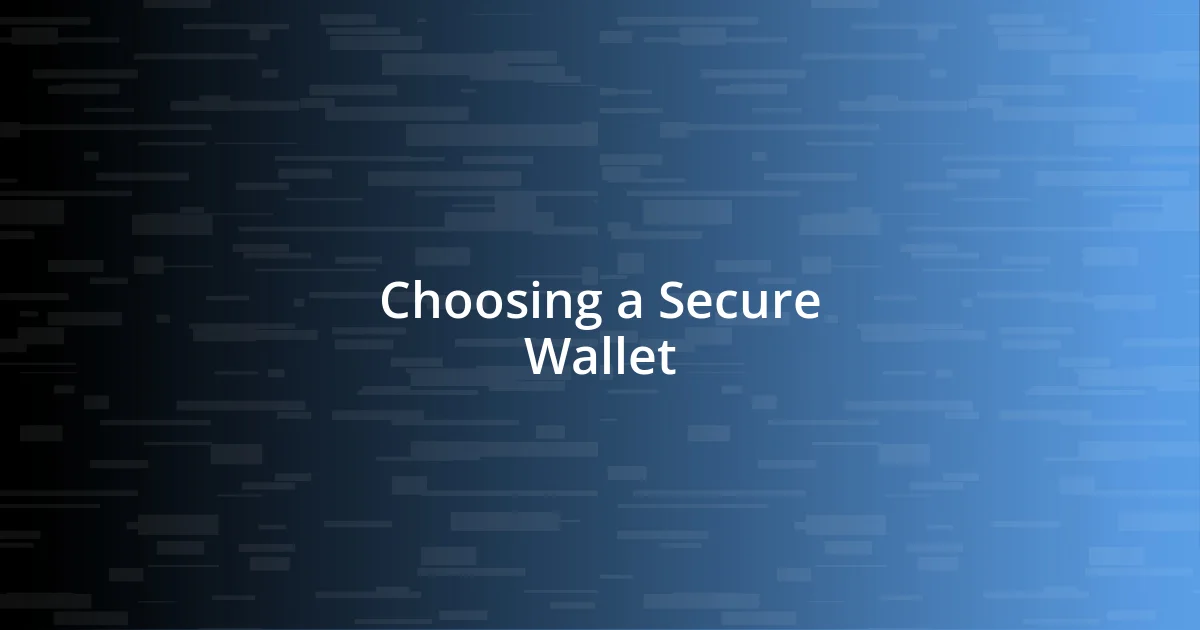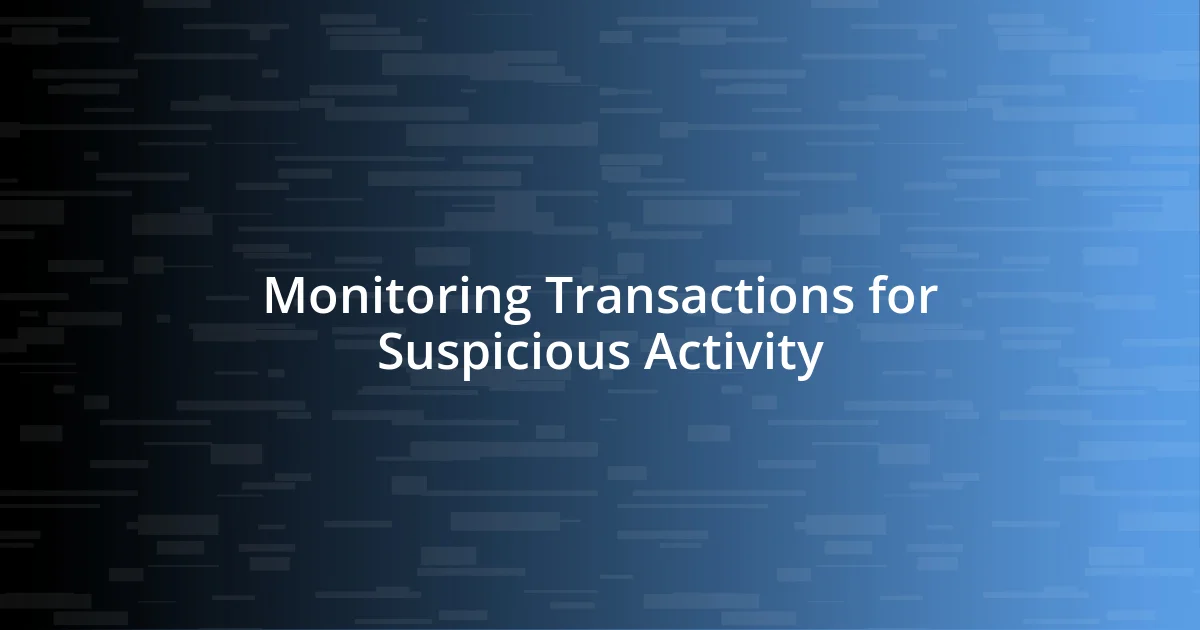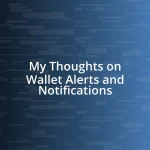Key takeaways:
- Utilizing a secure mobile wallet with features like encryption and multi-factor authentication is essential for protecting financial information.
- Regularly updating wallet software and monitoring transactions are critical practices that enhance security and allow for quick detection of suspicious activities.
- Establishing a reliable backup and recovery process ensures access to funds and data integrity in case of loss or malfunction.

Understanding Mobile Wallets
Mobile wallets are more than just digital storage; they’re a convenient extension of our everyday lives. I remember the first time I used one to pay for coffee—it was seamless, and it felt like I was stepping into the future. Don’t you find it fascinating how quickly technology can change the way we handle money?
Essentially, a mobile wallet allows you to store credit and debit card information on your smartphone, enabling tap-to-pay transactions and an array of digital services. It’s amazing to think about how this simple app can hold our entire purchasing capability. Have you ever considered how much lighter your wallet feels without all those physical cards weighing it down?
For many, mobile wallets bring a sense of security in a world where physical cash is sometimes seen as a liability. When I switched to a mobile wallet, I felt more in control of my spending, as I could easily track my transactions. Does anyone else feel more accountable when using a digital format for their expenses?

Choosing a Secure Wallet
Choosing a secure mobile wallet isn’t just about convenience; it’s about safeguarding your financial life. From my experience, opting for wallets that offer robust encryption and multi-factor authentication adds an extra layer of protection. Have you noticed how some wallets allow biometric security features like fingerprint scanning? It’s that added bit of reassurance that makes all the difference.
When comparing options, I always look closely at the wallet’s reputation and security track record. Some wallets have experienced breaches in the past, which makes me hesitant to trust them with my information. Every time I choose a wallet, I consider the company behind it and think about how they respond to security challenges. I want to invest my time and money in a place that values my security as much as I do.
Choosing a secure wallet also means examining user reviews and expert opinions. I spend time reading what others have experienced—nothing beats learning from real-life situations. A secure wallet should not only feel safe but also be easy to use. After all, it’s about balancing convenience with security, a principle that guides my selection process.
| Wallet Name | Security Features |
|---|---|
| Wallet A | Multi-factor authentication, encryption, biometric support |
| Wallet B | Encryption, backup options but no biometric security |
| Wallet C | Basic security features, no added layers |

Setting Up Two Factor Authentication
Setting up two-factor authentication (2FA) has become a crucial step in securing my mobile wallet. I can’t emphasize enough how empowering it feels to know that even if someone gets hold of my password, they still need a second form of verification. Every time I log in and receive a code on my phone, it’s like a little reminder that I’m taking my security seriously. Here’s a simple breakdown of how to set it up:
- Choose Your Wallet: Ensure your mobile wallet supports 2FA.
- Access Security Settings: Navigate to the security or account settings section.
- Enable 2FA: Follow prompts to turn on two-factor authentication.
- Select Verification Method: Choose between SMS, an authentication app, or email codes.
- Test the Setup: Log out and then back in to confirm everything works.
Each time I engage with my wallet, that extra step of verification gives me peace of mind as I conduct my transactions. I remember a moment when I almost used my wallet without activating 2FA; it felt like I was leaving my door wide open! Implementing 2FA not only secures my funds but also makes me feel more in control of my digital life.
In addition to the setup, I genuinely believe that using an authentication app rather than relying solely on SMS adds a stronger layer of security. There’s something much more reassuring about generating a code directly from an app — it just feels more secure. So, whenever possible, I opt for apps like Google Authenticator or Authy. They’re easy to use and provide that added shield. Plus, once I adjusted to the extra layer, I actually found it rather satisfying to take my security into my own hands.

Regularly Updating Wallet Software
Regularly updating the wallet software is a step I never overlook. I find it fascinating how many people forget this crucial task. Each update often comes with patches for security vulnerabilities, and skipping them feels like ignoring a warning light on your car’s dashboard. I can tell you from experience that taking a few moments to update can save you from headaches down the line.
When I receive a notification about an update, I immediately feel a mix of anticipation and reassurance. It’s a simple act, yet it profoundly affects my overall peace of mind. For instance, after one particular update, I noticed new security features that enhanced my wallet’s protection. The excitement of exploring those features made the update feel less like a chore and more like a reward for being diligent about my security.
I can’t help but wonder, do we fully grasp how these updates fortify our defenses? I once missed an update and later read about a vulnerability that had been fixed. That experience taught me that every update is not just an option but a necessity. Now, I’ve made it a routine to check for updates weekly, aligning it with my other tech habits. It’s a small commitment that pays off by keeping my financial information safer.

Using Strong and Unique Passwords
Maintaining strong and unique passwords is the backbone of my mobile wallet security strategy. I remember when I first learned this lesson; I had a simple password that I used across several accounts. One day, I received an email alert about a data breach, and my stomach dropped at the thought of my information being compromised. From that moment, I understood the importance of crafting complex, diverse passwords that make it difficult for anyone to guess.
Now, I create passwords that combine uppercase and lowercase letters, numbers, and special characters. Sometimes I use phrases that resonate with me instead of a single word—this way, I can easily remember them while keeping them unpredictable. For example, instead of “Cat123!” I might use “SunnyDays4MyFluffyCat!” It’s not only stronger but also brings a smile to my face when I think about my cat lounging in the sun. Have you ever thought about how a personal touch can strengthen your passwords?
I also make it a habit to change my passwords regularly, especially after hearing about security breaches. It feels empowering to take proactive steps for my safety. The last time I updated my password, I decided to use a password manager to help keep track of my unique passwords for each site. At first, I was hesitant, worried it might be yet another point of failure. But once I got comfortable with it, I realized it was a game changer. The convenience of having securely stored passwords allowed me to focus on what really matters—using my wallet without anxiety.

Monitoring Transactions for Suspicious Activity
Monitoring my mobile wallet transactions for suspicious activity is something I take very seriously. After a few close calls with unauthorized charges, I learned the hard way that staying vigilant can make all the difference. I’ve set alerts on my transactions, so any unexpected charge pops up on my phone instantly. This immediate feedback gives me peace of mind and helps me catch any suspicious activity before it spirals out of control.
I remember one incident where I received a notification about a small transaction I didn’t recognize while I was sipping coffee at my favorite café. My heart raced as I glanced at my screen. After a moment of panic, I quickly stumbled onto my wallet app, and to my relief, I saw that it was just a subscription I had forgotten about. That experience taught me how essential it is to engage with my financial activity regularly. It’s incredible how a simple notification can help maintain control over my finances.
I often wonder how many people overlook the importance of transaction monitoring. Have you ever thought about how quickly things can go wrong? I can tell you that having a proactive approach—like reviewing your transaction history weekly—has become a non-negotiable part of my routine. Not only does it showcase my spending habits, but it also opens the door for a clearer understanding of my financial landscape, making me feel empowered in a world where digital money is so prevalent.

Backup and Recovery of Wallet
When it comes to backing up my mobile wallet, I’ve made it a priority to maintain a secure recovery process. I recall a nerve-wracking moment when I accidentally deleted my wallet app during a routine cleanup on my phone. The sinking feeling of potentially losing access to my funds was alarming. Since then, I store my recovery phrases and backup wallets in a safe, offline location. This way, I’m assured that if something goes wrong, I can restore access with minimal hassle.
It’s also important for me to test my backups regularly. Early on, I had read about the importance of backup verification, but I didn’t realize its true value until I had a near miss with a malfunctioning app. The relief I felt after confirming that my backup was functional made it clear that I had to include this practice in my routine. Are you curious about how often you should check? I recommend doing it at least once every few months; it’s a small investment of time that pays off immeasurably in peace of mind.
I’ve learned to treat my wallet’s backup and recovery process like a safety net—essential but often forgotten. When I think about how quickly life can throw curveballs, like a lost phone or hardware failure, I can’t stress enough the importance of backing up. It’s all about protecting what matters. Have you ever had a moment where you wished you had a backup ready? I certainly have, and it’s those experiences that motivate me to stay vigilant and prepared.














